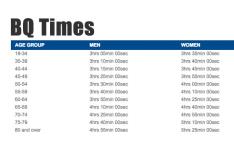
One of my athletes, long before I met him, ran 25 miles a few days before his first marathon so he could feel confident going into the race. Crashing 20 miles into the marathon, he realized that running that long that close to the marathon was a big mistake. With only a couple of months remaining until your marathon, every run is important.
Following are the key ingredients during the last eight weeks of marathon training.
Long Runs
The most important marathon preparation for the first-time marathoner is the long run. In addition to serving as a stimulus to store more glycogen, long runs improve your blood vessels' oxygen-carrying capability by increasing the number of red blood cells and hemoglobin concentration. They also create a greater capillary network, providing more oxygen to your muscles, and increase mitochondrial density and the number of aerobic enzymes, increasing your aerobic metabolic capacity. Long runs also prepare your muscles and connective tissue to handle the stress of pounding the pavement for 26.2 miles. For this reason, do all of your long runs on the road.
In the final eight weeks, do four to five more long runs, with at least two longer than 20 miles. While you certainly want to be confident that you can complete the marathon distance, you also need time to recover, so do your last long run two to three weeks before the marathon.
If you're more competitive and have a running background that has included many long runs, alternate your long run with a medium-long run (12 to 16 miles) that combines an easy run with segments at lactate threshold (LT) pace (what I call LT/LSD combo runs). These runs simulate the physiological and psychological fatigue of the marathon without having to run as far. Like regular long runs, they severely lower muscle glycogen, stimulating its synthesis and storage.
Lactate Threshold Runs
The lactate threshold (LT), an important physiological variable that demarcates the transition between exercise that is almost purely aerobic and exercise that includes significant oxygen-independent (anaerobic) metabolism, represents the fastest speed you can sustain aerobically and is the best physiological predictor of distance running performance. The longer the race, the more important it is to train your LT.
Lactate threshold training increases your LT to a faster speed, allowing you to run faster before you fatigue. The goal of marathon training is to raise your LT and to increase your ability to sustain as high of a percentage of your LT as possible. For average runners, LT pace is approximately 10 to 15 seconds per mile slower than 5K race pace (about 80 to 85 percent maximum heart rate). For those more trained, it's about 25 to 30 seconds per mile slower than 5K race pace and about 20 seconds per mile faster than marathon race pace (about 90 percent maximum heart rate). Subjectively, these runs should feel "comfortably hard."
I typically use three types of LT workouts with the marathoners I coach: 1) continuous runs at LT pace, starting at about 3 miles and increasing up to 7 to 8 miles (or about 45 to 50 minutes, whichever comes first); 2) intervals run at LT pace with short rest periods, such as 4 to 6 x 1 mile at LT pace with one minute rest; and 3) shorter intervals run at slightly faster than LT pace with very short rest periods, such as 2 sets of 4 x 1,000 meters at 5 to 10 seconds per mile faster than LT pace with 45 seconds rest and two minutes rest between sets.
In the final eight weeks of your marathon preparation, do one to two LT workouts per week. Four to 5 weeks before your marathon, try to find a half-marathon race. It not only serves as a great LT workout, it will help you predict your upcoming marathon pace.
- 1
- of
- 3
Get ACTIVE on the Go


Couch to 5K®
The best way to get new runners off the couch and across the finish line of their first 5K.
Available for iOS | Android







Discuss This Article